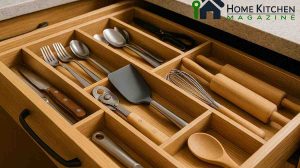How to prepare for a kitchen remodel can feel overwhelming, but it doesn’t have to be. Imagine transforming your outdated kitchen into a stunning, functional space where you can cook, entertain, and create memories. The process might seem daunting, but with the right preparation, you can turn your dream kitchen into a reality without unnecessary stress.
In this guide, we’ll walk you through everything you need to know about how to prepare for a kitchen remodel. From setting a budget to packing up your kitchen essentials, we’ll help you navigate the process step by step. By the end, you’ll feel confident and ready to tackle your remodel with ease.
Understanding the Scope of Your Kitchen Remodel
Before diving into the renovation, it’s crucial to define the extent of your project. Kitchen remodels can vary from minor cosmetic updates to complete overhauls. According to a study by Houzz, the median spend for a major kitchen remodel of a large kitchen (250 square feet or more) was $50,000, while a major remodel of a small kitchen (less than 250 square feet) had a median spend of $35,000.
How to Prepare for a Kitchen Remodel
1. Define Your Goals and Budget
Before diving into your kitchen remodel, it’s crucial to define your goals and establish a realistic budget. Ask yourself:
- What do I want to achieve with this remodel?
- What is my maximum budget?
Having clear goals will help you make informed decisions about materials, appliances, and design. For example, if your goal is to create a more open layout, you might need to allocate funds for structural changes.
2. Set a Realistic Budget
Establishing a budget is essential. Consider all potential expenses, including materials, labor, permits, and unexpected costs. Allocating a contingency fund of about 10-20% of your budget can help manage unforeseen expenses.
3. Plan Your Kitchen Layout
A well-thought-out layout is the backbone of any successful kitchen remodel. Consider the “kitchen work triangle” – the distance between the sink, stove, and refrigerator. This concept ensures efficiency and functionality.
Tips for planning your layout:
- Sketch your current kitchen and identify problem areas.
- Consult with a professional designer for expert advice.
- Prioritize storage solutions, such as pull-out shelves and deep drawers.
Exploring efficient kitchen storage solutions can greatly enhance functionality.
4. Hire Qualified Professionals
Selecting the right contractor is crucial for a successful remodel. Conduct thorough research, seek recommendations, and interview multiple contractors to find one that aligns with your vision and budget. Ensure they are licensed, insured, and have a portfolio of similar projects.
5. Prepare for the Renovation Process
Remodeling can disrupt your daily routine. Setting up a temporary kitchen in another part of your home can help maintain some normalcy. This space should include essential appliances like a microwave, toaster oven, and mini-fridge. Additionally, planning meals ahead or arranging alternative dining options can alleviate stress during construction.
Setting up a temporary kitchen requires thoughtful planning, similar to organizing your pantry.
6. Communicate Clearly with Your Contractor
Maintaining open and regular communication with your contractor ensures that the project stays on track. Discuss timelines, daily work schedules, and any concerns promptly to prevent misunderstandings.
7. Prepare Your Home for Construction
Remodeling can be messy, so it’s essential to prepare your home. Start by packing up your kitchen essentials and setting up a temporary cooking area.
Steps to prepare your home:
- Clear out your kitchen and store items in labeled boxes.
- Set up a temporary kitchen with a microwave, toaster oven, and mini-fridge.
- Protect adjacent rooms with plastic sheeting to contain dust.
8. Protect Your Home and Belongings
Dust and debris are inevitable during a remodel. Protecting adjacent rooms with plastic sheeting, covering furniture, and sealing vents can minimize the spread of dust. Removing valuable items from the work area is also advisable.
9. Anticipate the Unexpected
Despite careful planning, unforeseen issues may arise, such as hidden water damage or outdated wiring. Being flexible and prepared to adjust your plans or budget will help you navigate these challenges smoothly.
10. Focus on Quality Materials
Selecting the right materials and finishes can make or break your kitchen’s aesthetic. Opt for durable, easy-to-clean surfaces like quartz countertops and ceramic tile backsplashes.
Popular material choices:
- Countertops: Quartz, granite, or butcher block.
- Cabinets: Solid wood or MDF with a durable finish.
- Flooring: Hardwood, tile, or luxury vinyl.
Selecting the right appliances is crucial; refer to our guide on choosing the right kitchen appliances.
11. Plan for the Future
Consider how your needs might evolve over time. Incorporating universal design principles, such as accessible storage and adjustable countertops, can make your kitchen adaptable for years to come.
Wrap It Up
A kitchen remodel is a significant investment, but with careful planning and preparation, you can achieve a beautiful and functional space that enhances your home. By defining your goals, setting a budget, hiring experienced professionals, and staying organized throughout the process, you can minimize stress and enjoy the transformation.
For more kitchen remodeling tips and design inspirations, explore our articles on Home Kitchen Magazine. Happy remodeling!




 Home Kitchen Magazine is a blog dedicated to giving you inspiration and tips every day about the home, kitchen and garden.
Home Kitchen Magazine is a blog dedicated to giving you inspiration and tips every day about the home, kitchen and garden.

